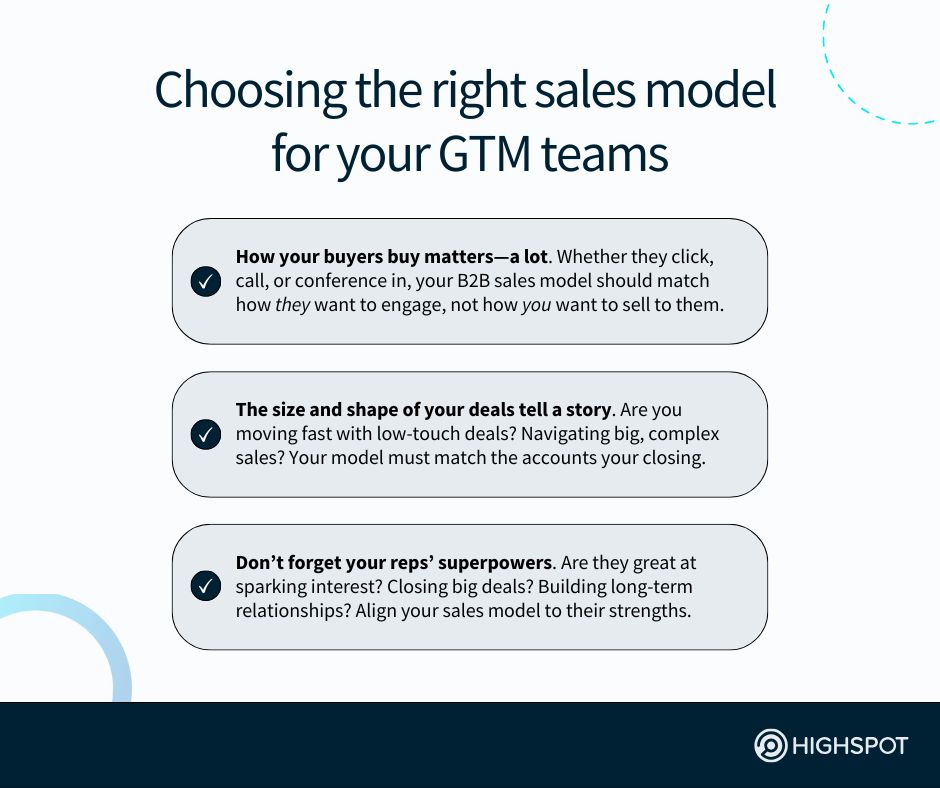Key Takeaways
- A well-defined sales model is the foundation for alignment across your GTM teams. It keeps sales, marketing, enablement, and RevOps working toward the same goals and provides visibility into what drives revenue.
- Choosing the right model means understanding your buyers deeply: how they want to engage with your sales team, how they evaluate potential solutions, and what ultimately drives their decision-making.
- Your sales model should evolve as your business grows, markets shift, and buyer behaviours change. Experimenting with hybrid models or new strategies can help you capture more opportunities and stay competitive.
Sales teams don’t fail because they lack effort. They fail because of misalignment.
Reps chase the wrong accounts and deals. Managers coach BDRs toward different goals. Enablement pushes content that doesn’t match the current motion.
Everyone’s working hard, but not necessarily in the same direction.
That’s where an agreed-upon sales model framework comes in.
If sales strategy were a puzzle, then your sales model would be a corner piece: It frames your approach to your customer’s business and determines how the other pieces—your sales methodology, process, and metrics—will fit together.
It provides structure that connects every GTM team, including revenue operations, helping you see the full picture of how deals move and why they close.
In this video, the Highspot team shares how to align the entire GTM organisation by working closely with key stakeholders across marketing, sales, and executive leadership.
What is a sales model?
A sales model refers to your organisation’s overall approach to selling. It shapes every step of the sales motion: from early-stage prospecting and lead qualification, to late-stage deal management and customer retention.
Your company’s sales model likely includes a blend inbound sales, outbound sales, and target account selling. That said, there is no one right sales model. The best one will depend on the complexity of your products or services, your target market, your average deal size, and your go-to-market (GTM) strategy.
For instance, a SaaS company selling enterprise software might lean on a consultative or account-based sales model. Meanwhile, a fast-growing startup offering a self-serve tool might focus more on inbound or transactional sales.
Ultimately, the right sales model provides structure and predictability. It gives your entire go-to-market function visibility into what drives revenue, helps managers train and coach more effectively, and gives reps a consistent framework to execute against, so the entire GTM engine moves in sync at all times.
Why do you need a sales model?
A sales model helps you see how and where you need to invest to grow your business. When implemented well, GTM teams can focus on the right activities, at the right time, for the right buyers, setting the stage for long-term sales success.
With a dedicated, structured sales approach in place, you get:
Clear direction and consistency with sales processes
In the absence of a defined sales model, every rep ends up building their own version of “what works.” One focuses on volume, another leans on relationships, and another improvises based on instinct. This leads to inconsistent results and limited visibility for go-to-market leaders trying to coach or forecast.
A well-structured sales model solves that by defining how your prospects move from first contact to close and what the best practice is at each step. More to the point, it gives your reps a shared sales playbook they can trust, while giving your managers a clear standard for performance and improvement.
With this structure, deals move faster (thanks to a unified, customer-centric selling approach used by every BDR and account executive), coaching becomes easier, and onboarding new sellers feels far less like starting from scratch.
Alignment across sales, marketing, and enablement
Sales doesn’t operate in isolation. Marketing, enablement, RevOps, and customer success all play a role in shaping the buyer experience. But without a shared selling framework from which to work, even small disconnects between these business units can quickly snowball into stalled deals and mixed signals for leads.
Your company’s sales model creates a shared foundation for how everyone engages with potential customers and multiple stakeholders at target accounts:
- Marketing knows exactly what “sales-ready” means.
- Sales leaders see what customer conversations work.
- Enablement understands what sales skills to reinforce.
- RevOps can track performance against expectations.
When everyone operates from the same model, silos break down. Hand-offs improve. Messaging stays consistent from first touch to renewal. And, most importantly, the customer experience becomes smoother and more impactful.
Scalability that supports growth without chaos
Without a defined sales model, scaling is risky.
What works for one team or rep might not translate to a new market, product, or region, especially when dealing with complex sales cycles. Worse, growth becomes dependent on your most successful salespeople (top performers who account for the bulk of your conversions) rather than on a repeatable system.
Simply put, a well-designed sales model changes that dynamic. Once your GTM organisation determines which sales activities, buyer interactions, and deal patterns lead to wins, those learnings can be standardised and taught.
More accurate forecasting and data-driven decisions
A well-defined model brings structure and visibility to every stage of the pipeline, leading to more accurate sales forecasting. You can see where deals tend to stall, what percentage typically convert, and how long each stage takes.
It also helps decision-makers across GTM prioritise investments. For instance, if data shows that conversion rates spike after targeted coaching or better enablement content, leaders know exactly where to allocate resources.
Over time, these valuable insights lead to smarter growth and more reliable revenue, empowering reps to improve their relationship-building and more capably engage and close qualified leads in a sustainable, scalable, repeatable manner.

Types of sales models
Sales models can vary, depending on a given company’s approach to demand generation, sales organisation structure, and more. That being said, there are some tried-and-true approaches that can help you close more deals, regardless of internal factors (industry, business model) or external market conditions.
Inbound sales
This approach focuses on attracting the right prospects by providing valuable content and solutions before they engage with a sales representative. It’s built around educating and nurturing leads until they are ready to buy.
Inbound sales uses digital marketing tactics like SEO, online advertising, content marketing, and social media to drive traffic. Leads typically come in through blog posts, white papers, webinars, or email sign-ups, and sales teams prioritise them based on intent signals like website visits or content downloads.
Inbound sales reps then step in once prospects show interest, making the process more consultative and less aggressive and providing greater value to leads, as they continue to engage further with the brand’s digital touchpoints.
Expert inbound selling tips:
- Guide, don’t push. Let interested buyers move at their own pace while you support them with the right content and conversations to inform their decision-making process.
- Personalise based on context. Instead of generic follow-ups, tailor outreach to the specific content, use case, or pain point a buyer has already shown interest in.
- Close the content gap. If reps keep answering the same questions, that’s a content opportunity marketing can build (read: address customers’ issues with new assets).
Outbound sales
In this model, your sales reps go out and find potential buyers. They usually start with a list of prospective clients who fit a certain profile, even if they haven’t shown interest yet. It’s direct, aggressive, and highly effective when done right.
Sales reps generate leads through cold calls, email, SMS, and networking, targeting prospects based on firmographics, job titles, and industry data. They follow structured sales sequences and use automation tools to streamline outreach. The goal is to start conversations, qualify leads, and move them through the sales funnel.
Expert outbound selling tips:
- Tighten your ideal customer profile (ICP). Ensure your reps are targeting prospects most likely to buy— not just the ones easiest to reach.
- Sharpen your value proposition. Buyers should instantly understand why you’re the better choice.
- Automate your process. Automate repetitive tasks like sequencing, data entry, dialling, and contact research so reps can spend more time actually selling.
Account-based selling
Account-based selling is a laser-focused sales approach in which all sales and marketing efforts focus on engaging high-value accounts. Go-to-market teams perform extensive research and take a highly personalised approach, tailoring all elements of the deal to meet the customer’s demands.
Modern account-based selling for enterprises requires a rigorous qualification process to identify key accounts that match your ideal customer profile.
Sales, marketing, and customer success teams work together to create personalised sales pitches, content, and strategies for each account. This approach aims to build deep relationships through multi-touch, multi-channel engagement.
Expert account-based selling tips:
- Expand relationships early. Coach reps to multi-thread before the first meeting closes. Spreading relationships across the account protects pipeline and shortens deal cycles.
- Focus on high-touch engagements. According to DemandGen’s 2025 ABM Benchmark Survey, sales meeting invitations (54%) and executive event invitations (38%) are the most effective account-based approaches. It makes sense: These create direct access to decision-makers and spark deeper conversations that move deals forward.
- Build a connected GTM stack. Equip your GTM stack with real-time analytics and enablement tools so you can personalise outreach, align teams, and scale ABS strategies rather than just trying to do “more of the same.” The right tools enable a consultative selling approach.
Self-service sales
This model allows your buyers to self-service the entire sales process on your website, from education to solution purchase. These leads find, evaluate, and buy products entirely online, often through a product-led growth (PLG) approach that uses free trials or freemium versions to drive adoption.
Chatbots, knowledge bases, and automated onboarding provide support for new customers who purchase a given product or service. Meanwhile, in-app upselling and automated marketing workflows help convert users into paying customers.
Expert self-service sales tips:
- Design the product to sell itself. Make sure the path from “I’m interested” to “I’m using this every day” feels effortless. It should provide intuitive onboarding, helpful prompts, and clear value within minutes.
- Support without slowing them down. In-app guidance, chatbots, and helpful resources should remove friction, not force someone into a conversation they don’t want yet.
- Track user intent signals. Monitor actions like feature adoption, seat expansion, and repeat logins so sales teams can step in with the right message at the right moment.
The ultimate checklist for choosing and implementing a sales model
You know the basics. Now, it’s time to decide which sales model you’ll use. Some key factors you’ll want to consider and how best to put them into action include:
1. Defining (or redefining) your buyer personas
First, define your buyer personas. As already mentioned, your sales model will determine how you bring new leads into your sales funnel. But that approach will vary based on who your buyers are and how they want to buy.
For instance, if your buyers tend to be mid-level employees who prefer to do their own research, a self-service model may allow you to quickly and efficiently generate new business.
On the flip side, if your buyers are C-suite executives who demand tailored solutions, an account-based approach will serve you better. Knowing who your buyers are will help set you on the right path to choosing a sales model that meets them where they are.
2. Understanding the average buyer’s journey
Next, map out your buyer’s journey. Similar to understanding your buyer personas, a deep understanding of your buyer’s journey will help you determine which sales model is best for your business.
Consider how and where you interact with your buyers throughout the sales cycle, how buyers respond to the resources and tools you provide them, and how long they spend with each. The answers here will reveal buyer expectations, allowing you to select a sales model that is tailored to their preferred experience.
3. Letting your sales strategy guide your model
Think about your product, pricing, and current competitive landscape. What kind of solution are you selling? Who else is selling it? How do they attract buyers? Will you beat them on value or price? How do you expect the market to evolve over time?
The answers to these questions will help you determine which sales model is best for your business approach and aligns with your B2B sales strategy.
For example, if you sell a relatively simple solution in a saturated market, you are unlikely to find success with a highly personalised approach to sales and may very well lose money pursuing an account-based sales model. Here, a self-service model is ideal so you can and double down on customer service.
4. Upgrading your sales technology stack
Match your go-to-market software to the sales model you’ve selected, not the other way around. Consider both current sales tools already in your tech ecosystem and future investments you will need to support your buyer’s journey.
“A winning framework includes equipping sellers with easy-to-access tools, clear actions, the capability to personalise content, comprehensive virtual engagement channels, and asynchronous communication tools,” Highspot’s Best Practices to Engage the Modern Buyer Guide explains.
Besides the foundational solutions—your CRM, marketing automation systems, and sales engagement tools—you also need a purpose-built, AI-powered sales enablement platform that supports how your sellers execute your model.
Consider Highspot. Our agentic platform for GTM teams not only connects targeted content, guidance, and training directly to the buyer’s journey, but also provides customisable digital sales rooms. This gives prospects a personalised space to explore content and move deals at their own pace.
Combined with cutting-edge artificial intelligence that learns from your deals and process, reps can apply your sales model consistently and confidently.
5. Enabling your team with guidance and support
Once you have your model, strategy, and tech stack in place, the real work begins: enabling your customer-facing teams to consistently execute. They need easy access to the right content, clarity on how to use it, and skill-building support that keeps up with shifting buyer expectations.
That goes beyond a one-time onboarding. Sales professionals need ongoing guidance — whether that’s through sales plays that simplify the “what to do next” moments, or training that keeps them aligned with your sales goals and strategy.
Highspot makes that possible. With AI role play, reps can practise sales conversations using real messaging and scenarios, then get immediate feedback to improve before they’re in front of a buyer. Meanwhile, AI agents surface deal risks, highlight next steps based on buyer activity, and point managers to better coaching moments.
6. Continuously tracking your GTM performance
Think about how you are going to measure the success of your current sales model. As noted, you may outgrow your initial selection. Alternatively, you may choose to add a second or third sales model to reach different buyer personas.
With that in mind, it’s essential to continuously examine whether or not your sales model is meeting your goals and where opportunities for optimisation exist.
Turn your sales model into tangible results with leading GTM tools
Choosing the right sales model isn’t a one-time decision.
It’s a perpetual approach that shapes how your sales reps engage buyers, prioritise opportunities, and collaborate across teams. Success becomes repeatable when your model aligns with buyer expectations and your sales organisation has the tools and guidance to execute consistently.
But to achieve sustainable, scalable success, you must regularly measure, refine, and adapt. Use data to uncover gaps, AI and enablement platforms to streamline execution, and structured sales processes to guide your team at every stage.
Many businesses use a combination of models to support different buyer segments, so don’t be afraid to mix and match. By treating your sales model as a living framework, you create an environment where sales teams aren’t just meeting quotas—they’re driving consistent, predictable sales results.




